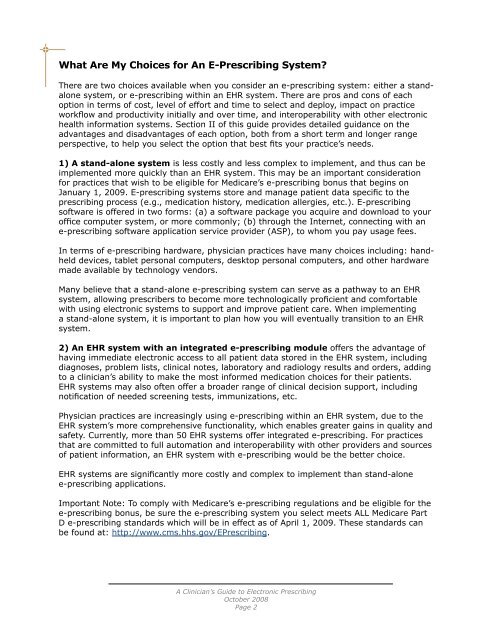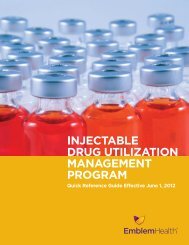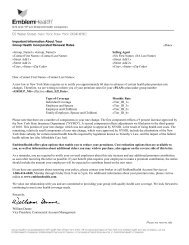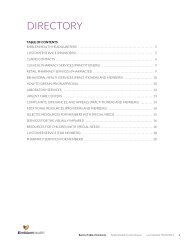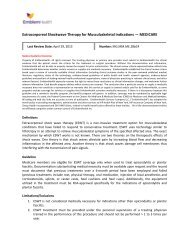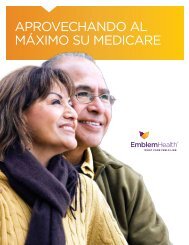A CLINICIAN'S GUIDE TO ELECTRONIC PRESCRIBING
A CLINICIAN'S GUIDE TO ELECTRONIC PRESCRIBING
A CLINICIAN'S GUIDE TO ELECTRONIC PRESCRIBING
Create successful ePaper yourself
Turn your PDF publications into a flip-book with our unique Google optimized e-Paper software.
What Are My Choices for An E-Prescribing System?<br />
There are two choices available when you consider an e-prescribing system: either a standalone<br />
system, or e-prescribing within an EHR system. There are pros and cons of each<br />
option in terms of cost, level of effort and time to select and deploy, impact on practice<br />
workflow and productivity initially and over time, and interoperability with other electronic<br />
health information systems. Section II of this guide provides detailed guidance on the<br />
advantages and disadvantages of each option, both from a short term and longer range<br />
perspective, to help you select the option that best fits your practice’s needs.<br />
1) A stand-alone system is less costly and less complex to implement, and thus can be<br />
implemented more quickly than an EHR system. This may be an important consideration<br />
for practices that wish to be eligible for Medicare’s e-prescribing bonus that begins on<br />
January 1, 2009. E-prescribing systems store and manage patient data specific to the<br />
prescribing process (e.g., medication history, medication allergies, etc.). E-prescribing<br />
software is offered in two forms: (a) a software package you acquire and download to your<br />
office computer system, or more commonly; (b) through the Internet, connecting with an<br />
e-prescribing software application service provider (ASP), to whom you pay usage fees.<br />
In terms of e-prescribing hardware, physician practices have many choices including: handheld<br />
devices, tablet personal computers, desktop personal computers, and other hardware<br />
made available by technology vendors.<br />
Many believe that a stand-alone e-prescribing system can serve as a pathway to an EHR<br />
system, allowing prescribers to become more technologically proficient and comfortable<br />
with using electronic systems to support and improve patient care. When implementing<br />
a stand-alone system, it is important to plan how you will eventually transition to an EHR<br />
system.<br />
2) An EHR system with an integrated e-prescribing module offers the advantage of<br />
having immediate electronic access to all patient data stored in the EHR system, including<br />
diagnoses, problem lists, clinical notes, laboratory and radiology results and orders, adding<br />
to a clinician’s ability to make the most informed medication choices for their patients.<br />
EHR systems may also often offer a broader range of clinical decision support, including<br />
notification of needed screening tests, immunizations, etc.<br />
Physician practices are increasingly using e-prescribing within an EHR system, due to the<br />
EHR system’s more comprehensive functionality, which enables greater gains in quality and<br />
safety. Currently, more than 50 EHR systems offer integrated e-prescribing. For practices<br />
that are committed to full automation and interoperability with other providers and sources<br />
of patient information, an EHR system with e-prescribing would be the better choice.<br />
EHR systems are significantly more costly and complex to implement than stand-alone<br />
e-prescribing applications.<br />
Important Note: To comply with Medicare’s e-prescribing regulations and be eligible for the<br />
e-prescribing bonus, be sure the e-prescribing system you select meets ALL Medicare Part<br />
D e-prescribing standards which will be in effect as of April 1, 2009. These standards can<br />
be found at: http://www.cms.hhs.gov/EPrescribing.<br />
A Clinician’s Guide to Electronic Prescribing<br />
October 2008<br />
Page 2


